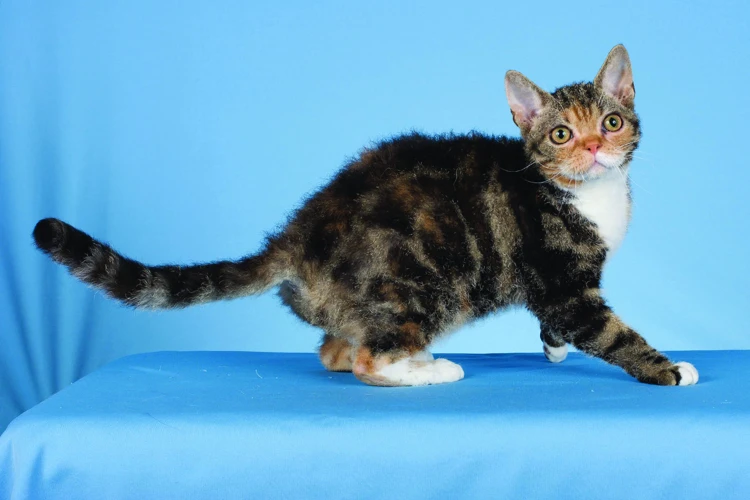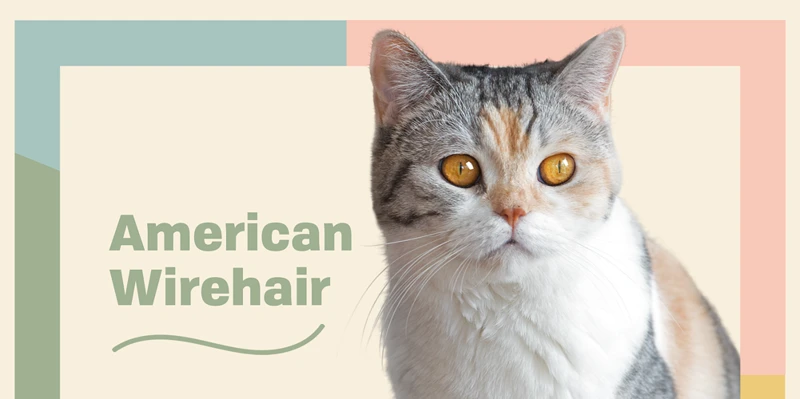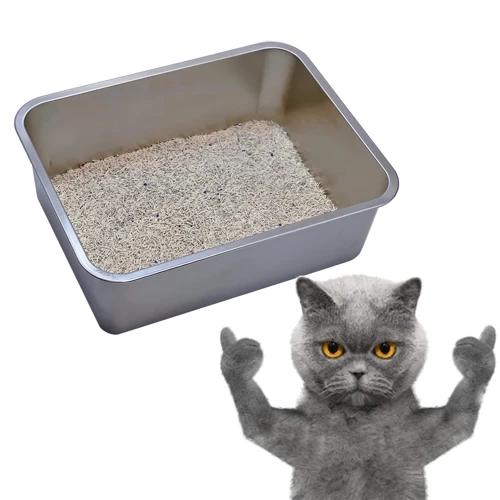As a cat owner, you might have experienced the challenge of transitioning your American Wirehair to a new litter box. Whether it is because of health concerns or simply a desire to upgrade, the process can be daunting. Your feline friend might be resistant to the change, resulting in stress and anxiety for both you and your cat. But fear not! In this article, we will provide you with step-by-step guidance on how to make this transition as smooth as possible, while minimizing any discomfort or fear that your cat might experience. From understanding your cat’s behavior to creating a positive association with the new litter box, we have got you covered. So let’s get started!
Understanding Your Cat’s Behavior

As a pet parent, understanding your American Wirehair’s litter box behavior is vital to provide a hygienic and comfortable environment for your furry companion. Cats may display stress and anxiety when exposed to new situations, so it’s important to be patient and supportive throughout the litter box transition process. Before moving on to the practical steps, let’s take a closer look at how American Wirehairs adapt to changes and what you can do to reduce potential anxiety and litter box problems. For more tips on American Wirehair litter training, check out our guide to litter training American Wirehair kittens.
Adapting to Change
Adapting to Change: American Wirehairs are creatures of habit and routine, and they often struggle with change. This can be especially true when it comes to their litter box. Whether you are transitioning to a new box, new litter brand, or new location, your cat will need time to adjust to the unfamiliar surroundings. Be patient and understanding, as your cat may experience confusion and distress during the transition. You can ease the process by providing comfort, familiarity, and consistency.
Some tips for helping your American Wirehair adapt to change include:
- Introduce changes gradually, giving your cat time to adjust.
- Use positive reinforcement to encourage desired behavior with treats or affection.
- Provide a comfortable and safe environment with familiar scents and objects.
- Ensure that your cat has ample opportunity to express natural behaviors and instincts.
- Watch for signs of stress or anxiety, such as hiding, avoidance, or vocalization.
By understanding your American Wirehair’s needs and behavior, you can better support them during times of change and ensure a smooth transition. If you are having trouble with your cat’s litter box behavior, it may help to explore other resources on American Wirehair Litter Box Behavior, such as litter box problems, reinforcement training, or toilet training pros and cons.
Preventing Stress and Anxiety
Preventing Stress and Anxiety in your American Wirehair is crucial during any transition. Cats can become easily stressed and anxious, which can cause them to develop negative feelings towards using the litter box. To prevent this, there are a few things you can do.
Firstly, make sure to provide your cat with plenty of positive reinforcement throughout the transition process. Reinforcing positive behavior can help reduce stress and anxiety levels by creating a positive association between your cat and the new litter box. Consider using treats or verbal praise to make your cat feel comfortable and confident when using the new litter box.
Maintaining your cat’s daily routine can help prevent stress and anxiety. Cats are creatures of habit and thrive on consistency. Try to maintain feeding schedules, playtimes, and other daily activities as close to normal as possible throughout the transition period.
Another way to prevent stress and anxiety is to choose the right time to make the transition. If your cat is experiencing any other stressors, such as a move to a new home or the introduction of a new pet, it may not be the best time to transition to a new litter box. Wait until your cat is feeling secure and calm before making any changes.
Finally, consider the type of litter box you are transitioning your cat to and whether it is appropriate for their needs. Some American Wirehairs may require a larger or covered litter box to feel comfortable. Choosing the right litter box can make the transition easier and less stressful for your cat.
For more information on litter box options for American Wirehairs, check out our article on the best litter box for American Wirehairs. Also, learn more about positive reinforcement techniques for litter training in our article on positive reinforcement litter training for American Wirehairs.
Gather Necessary Supplies

When transitioning your American Wirehair from one litter box to another, it’s important to have all the necessary supplies ready before starting the process. This will help make the transition as smooth and stress-free as possible. Some of the necessary supplies include:
1. New Litter Box: You will need a new litter box to help your cat adapt to using a new environment when going to the toilet. Choose a litter box that is of the appropriate size and depth for your American Wirehair. Also, ensure that the box is comfortable and sturdy, ideally with a design that helps reduce litter tracking in your home.
2. Litter: Choose the type of litter that your cat is familiar with, especially because American Wirehairs tend to be used to a particular brand or type of litter. You can gradually transition your cat to a new type of litter later on if you want to make any changes.
3. Scoop or Litter Scoop: This helps you remove clumped and solid waste from the litter box easily and quickly. A litter scoop allows you to clean the litter box without replacing all the litter every time.
4. Old Litter Box: You will need to keep your old litter box for a while, even if you no longer use it, as it plays a significant role in helping your cat transition smoothly to a new litter box.
5. Cat Attractants: These are products that encourage your cat to use the litter box. They are especially helpful if you are introducing a new litter box in a new location. Cat attractants come in different forms, including sprays and powders that you can apply to the litter box.
6. Cleaning Supplies: You will need cleaning supplies such as a disinfectant, a scrub brush, and gloves to clean the old litter box and maintain the new one. It’s important to keep the litter box and the surrounding area clean to prevent infections and odors.
Once you have all the necessary supplies, you can start the process of transitioning your American Wirehair from one litter box to another. Make sure you follow the steps and tips outlined in this article to ensure a successful transition for both you and your cat. Don’t forget to clean and maintain the new litter box regularly to ensure your cat is healthy and happy. You can learn more about American Wirehair litter box issues and how to avoid them by reading our article American Wirehair Litter Box.
Creating a Positive Association with the New Litter Box

When introducing a new litter box to your American Wirehair, it’s crucial to create a positive association with it. This can be achieved through various strategies that will ensure your pet’s comfort and familiarity with the new setup. By doing so, you can prevent any litter box-related problems from arising. In this section, we will discuss some tips on how to create a positive association with the new litter box for your American Wirehair. From choosing the right location to reinforcing positive behavior, we’ll cover everything you need to know to successfully transition your pet to the new litter box.
Choosing the Right Location
Choosing the Right Location:
Choosing the right location for the new litter box is crucial for your American Wirehair’s successful transition. Consider placing the litter box in a quiet and private area of your home to avoid distractions and ensure that your cat has enough privacy. Avoid placing it near their feeding area or in a high-traffic area of your home, as this can cause stress and anxiety, which may lead to litter box avoidance and other unwanted behaviors.
Additionally, placement near windows or doors can cause drafts that may make your cat uncomfortable. Choose a dry and well-ventilated area that is easy to access for your cat, especially if they are elderly or have mobility issues.
It is important to note that some American Wirehairs may have preferences for covered or uncovered litter boxes and the type of litter inside. Consider experimenting with different types of litter boxes and litter until you find one that your cat is most comfortable with.
Once you have chosen the location for the new litter box, make sure to keep it clean and well-maintained to prevent any litter box problems. Regular cleaning and maintenance of the litter box will also help to prevent the spread of bacteria and keep your home cleaner and more hygienic.
For more information on cleaning and maintaining your American Wirehair’s litter box, check out our article on How to Clean Your American Wirehair’s Litter Box.
Introducing the New Box
When introducing the new litter box to your American Wirehair, it’s important to do so gradually to prevent any stress or anxiety. Start by placing the new litter box next to the old one so your cat can become familiar with it. Be sure to put some litter in the new box so they can explore the scent. You can also put a small amount of litter from the old box in the new one to help your cat become familiar with the new box.
After a few days, move the new box a few inches closer to the desired location. Continue this process every few days until the new box is in its desired location. It’s important to note that the new box should be at least two feet away from their food and water bowls to avoid any unpleasant odors.
You can also try placing treats or toys near the new litter box to encourage your cat to explore the area. Positive reinforcement is key in getting your American Wirehair to successfully transition to the new litter box.
Remember that each cat is different, and some may take longer to adapt to the new litter box than others. Be patient and monitor their behavior closely during the transition period. If you notice any issues, such as inappropriate elimination or refusal to use the new box, consult with your veterinarian for additional advice.
By following these steps, you can help your American Wirehair successfully transition to their new litter box without any added stress or anxiety.
Link to related article: American Wirehair Litter Problems
Encouraging and Reinforcing Positive Behavior
When transitioning your American Wirehair to a new litter box, it is important to encourage and reinforce positive behavior. Here are some tips to help you do this:
- Give Praise: Whenever your cat uses the new litter box, make sure to praise them. This can be done through verbal reinforcement and even treats.
- Be Consistent: Make sure to consistently use positive reinforcement every time your cat uses the new litter box. This will help them to associate using it with good things.
- Remove Negative Associations: If your cat has had negative experiences with litter boxes in the past, it’s important to remove those negative associations. This may involve switching litter types or cleaning the box more frequently.
- Monitor Behavior: Keep an eye on your cat’s behavior when using the new litter box. If they seem hesitant or refuse to use it, consider making changes to the location or design of the box.
- Be Patient: Remember that transitioning to a new litter box can take time. Be patient and continue to use positive reinforcement to encourage your cat to use the new box.
It’s important to note that toilet training your American Wirehair comes with its own pros and cons. Learn more about it in our guide to American Wirehair toilet training pros and cons.
Transitioning Your American Wirehair to the New Litter Box

Now that you have prepared your cat for the switch, it’s time to start the transition. This can be a daunting process, but it’s important to take things slowly and remain patient. Your American Wirehair may take some time to adjust to the new litter box, but with the right approach, it will be a smooth and stress-free process for both you and your furry friend. Let’s dive in and explore how you can make the transition as seamless as possible.
Gradual Transition
To transition your American Wirehair from their old litter box to a new one, a gradual transition is usually the best approach. This allows your cat to adjust slowly to the new environment without getting overwhelmed. The process involves gradually replacing the old litter box with the new one over a period of several days or weeks. Here are the steps to follow for a successful gradual transition:
Step 1: Introduce the new box
First, place the new litter box next to the old one. Leave it there for a couple of days to give your cat time to get used to its presence. This will help your cat form a positive association with the new litter box.
Step 2: Replace the litter
After a few days, start adding small amounts of the new litter to the old litter box. This will allow your cat to gradually become familiar with the new litter scent and texture.
Step 3: Increase the amount of new litter
Over the next few days, gradually increase the amount of new litter in the old box while decreasing the amount of old litter. You can do this by adding more new litter each day and removing some of the old litter.
Step 4: Use only the new box
Once the old litter box has mostly new litter, you can begin using only the new box. At this point, you can remove the old litter box entirely. However, keep in mind that some cats may take a little longer to fully switch over. If your cat still uses the old litter box, continue with the gradual transition process until the new box is their primary choice.
Step 5: Observe and adjust
During this process, closely observe your cat’s behavior around the new litter box. If your cat seems hesitant, try placing treats or toys near the box to encourage exploration. Additionally, if you notice your cat accidentally eliminating outside of the new box, it may be too small or in a location that your cat finds uncomfortable. Try moving the box or choosing a different size or style of litter box.
By following these steps, you can help your American Wirehair transition smoothly to a new litter box without stress or anxiety. Remember to be patient and make adjustments as necessary for your cat’s needs.
Full Transition with Close Monitoring
When you feel that your American Wirehair has adjusted to the new litter box, it’s time to switch over completely. Start by removing the old litter box and leaving only the new one. Monitor your cat closely and keep an eye out for any signs of distress or reluctance to use the new box.
Continue to reward positive behavior and provide lots of encouragement during this transition. You may want to temporarily restrict access to other parts of the house to encourage your cat to use the new litter box.
If your cat is still hesitant to use the new litter box, try adding some of their old litter to the new box at first. Gradually decrease the amount of old litter and increase the new litter until your cat is using the new litter exclusively.
It’s important to be patient and consistent during this process. Remember that every cat is unique and may require more or less time to adjust to the new litter box. But with a little patience and positive reinforcement, your American Wirehair should successfully transition to the new litter box in no time.
Cleaning and Maintaining the New Litter Box
Keeping your cat’s litter box clean is essential for their health and well-being. Once you have successfully transitioned your American Wirehair to the new litter box, you must maintain it properly.
Scoop Every Day: Make it a habit to scoop the litter box at least once a day. American Wirehairs are clean cats, and a dirty litter box can cause stress and anxiety. Scooping daily also helps you keep track of any changes in your cat’s urine or feces, which could indicate an underlying health issue.
Empty and Clean Weekly: Once a week, you should empty the litter box completely and clean it with warm water and mild soap. Avoid using harsh chemicals, as these can be harmful to your cat. Rinse thoroughly and dry the litter box before adding fresh litter.
Choose the Right Litter: American Wirehairs are sensitive to certain smells and textures. Choose a litter that your cat prefers and stick with it. Switching litters can cause stress and anxiety, undoing all your hard work in transitioning your cat to the new litter box.
Replace the Litter Box: Over time, litter boxes can become scratched and damaged, leading to bacteria and odors that can be difficult to remove. Replace the litter box every six months to a year, or sooner if there are signs of wear and tear.
By keeping your cat’s litter box clean and well-maintained, you are providing a safe and comfortable space for them to do their business. This can improve their overall health and happiness, while also reducing the risk of litter box-related problems in the future.
Conclusion
After following the steps outlined in this article, transitioning your American Wirehair to a new litter box should not be a daunting task. Remember to always observe your cat’s behavior carefully and adapt to its reaction accordingly. Keep in mind that cats can be sensitive to change, so patience and persistence are key.
By understanding your cat’s behavior and creating a positive association with the new litter box, your cat will be more likely to adjust well to the new environment. Use treats, praise, and positive reinforcement to encourage good behavior, and avoid scolding or punishing your cat.
During the transition process, it is important to clean and maintain the new litter box regularly, as well as the surrounding area. This will help to prevent any unpleasant odors or messes that could discourage your cat from using the new litter box.
Remember that each cat is different and may need varying levels of time and attention during this transition. Be attentive to your cat’s needs and adjust accordingly.
Overall, moving your American Wirehair to a new litter box should be a positive experience with a little bit of preparation and patience. By following the steps in this article and staying positive, you can successfully transition your cat to a new litter box with ease.
Frequently Asked Questions
1. How long does it take to transition an American Wirehair to a new litter box?
It varies from cat to cat. Some cats adjust in a few days while others may take up to a few weeks. It’s important to take a gradual approach to make sure your cat adapts comfortably.
2. Should I use the same type of litter in the new box?
Yes, using the same type of litter helps your cat adjust. If you want to change the litter type, do it gradually after your cat has fully transitioned to the new box.
3. Can I use a covered litter box?
Yes, you can use a covered box if your cat is comfortable with it. However, some cats prefer an open box as they feel less confined and have more room to move.
4. How often should I clean the new litter box?
It’s recommended to scoop the litter box daily to keep it clean and prevent odors. Clean the box thoroughly and change the litter once a week.
5. What if my cat refuses to use the new litter box?
If your cat refuses to use the new box, go back to the previous one and start the transition process again later. It’s important to not force your cat or punish them as it can cause stress and anxiety.
6. Can I use a different litter box shape or size?
Yes, you can use a different box shape or size. Just make sure it’s large enough for your cat to move around comfortably and has enough depth for the litter.
7. What if my cat has urinary tract issues during the transition?
If your cat has urinary tract issues during the transition, consult with a veterinarian as soon as possible. They may suggest changing the litter type or other adjustments to help your cat.
8. Can I use multiple litter boxes?
Yes, you can use multiple litter boxes if you have multiple cats. It’s recommended to have one box per cat plus an additional one.
9. Should I use scented litter?
It’s best to avoid scented litter as it can be overwhelming for some cats. Stick to unscented litter to reduce the risk of adverse reactions.
10. What if my cat still prefers the old litter box?
If your cat still prefers the old litter box, continue using it and try the transition process again later. It’s important to keep your cat comfortable and avoid causing them undue stress.







